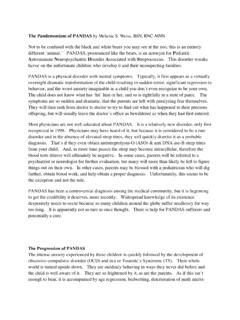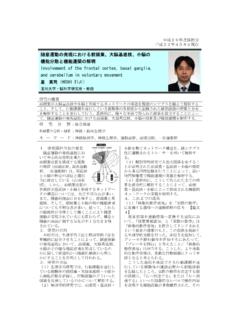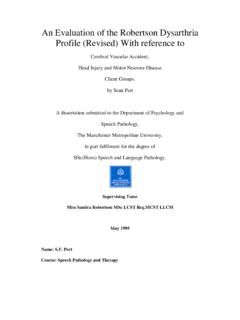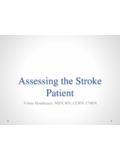Transcription of Parkinson Wellness Recovery (PWR!) Guidelines to …
1 Parkinson Wellness Recovery (PWR!). Guidelines to Treating People with Parkinson 's Disease September 14, 2017. Shana Gatschet, OTR/L, CAPS. Michelle Drinnen, OTR/L. PWR! What is it? Parkinson Wellness Recovery PWR Professionals (FB). Parkinson Wellness Recovery Nonprofit organization founded in 2010 by Dr. Becky Farley PhD, MS, PT. Implements cutting edge research on exercise and brain change to real world healthcare paradigms Dr. Farley is also the developer of evidenced based therapy approach of LSVT BIG. PWR! Dr. Farley's PWR! Center is a Community NeuroFitness Center of Excellence in Tucson, AZ. Promotes Exercises as Medicine . Her PWR! Gym is offered to people with PD to have access for life to increase longevity and quality of life in hopes that end stage PD is eradicated Framework is founded on clinical research in motor control, motor learning, exercise and physiology.
2 What is Parkinson 's Disease? Neurodegenerative, chronic and progressive movement brain disorder that progresses slowly in most people It involves the malfunction or death of neurons that produce dopamine. Dopamine is a chemical concentrated in the substantia nigra that controls movement to be smooth and coordinated When diagonosed, ~ 60-80%of the dopamine-producing cells are damaged or die, PD symptoms appear At diagnosis, many are already less active than healthy peers. Poor body awareness effects one's perception of true movement quality. Yet, only 12- 15% are typically referred to a fitness program or therapy. 6-7 million people worldwide are diagnosed; 2% of the population 6 Primary Features of PD. *Resting Tremors Definite DX: of at least 2 of these with one as tremor or bradykinesia *Rigidity Probable: Tremor or Bradykinesia *Bradykinesia present *Loss of Postural Reflexes Possible: at least 2 of the last four are present *Flexed Posture *Freezing PD Symptoms Early Motor Symptoms: decreased arm swing when walking, masked face, stooped posture, micrographia, hypophonia, slow shuffling gait, clumsy hands, falls when fatigued or in a hurry/stressed/distracted Primary Motor Symptoms upon diagnoses: Rigidity, Bradykinesia, Incoordination Non-Motor Symptoms: Emotional: depression, anxiety, apathy Cognitive: attention, executive function Autonomic: sleep, constipation, pain Stages of PD.
3 Stage 0 No signs of disease Stage 1 Unilateral disease Stage Unilateral plexus axial involvement Stage 2 Bilateral disease, without impairment of balance Stage Mild bilateral disease, Recovery on Pull Test Stage 3 Mild to Moderate bilateral disease: some postural instability, independent living capacity Stage 4 Severe disability, able to ambulate and stand unassisted Stage 5 Wheelchair bound or bedridden unless assisted Causes? Head injury/Brain swelling Free radicals High iron and manganese (welding). TIAs, Brain Tumors or Lesions near Brainstem Medications Street drugs Viral infection Carbon monoxide Research Research advances and clinical science research suggest certain types of exercise may promote brain change (neuroplasticity) in persons with PD. This data challenges the assumption that PD as a neurodegenerative disease has no potential for brain change or repair (neuroplasticity).
4 Yet many physicians are unaware of the scientific literature and animal science underlying exercise-induced Neuroplasticity When it comes to Brain Change or neuroplasticity, it's more than just what you 's HOW you do it! . Exercise for Brain Change helps optimize and repair brain health to address the cognitive, physical and emotional symptoms of PD that interferes with everyday activities. Why is exercise so important? PD is the ONLY chronic neurodegenerative disease for which these are highly effective symptomatic therapies 3 options that reduce motor symptoms and/or disability in PD. Medications (that target dopamine). Neurosurgery (DBS). Research shows Brain Change Data from animal models: NeuroProtection (Brain Health) Capable of protecting vulnerable DA. neurons from toxic events or rescuing those that are not compromised.
5 NeuroRestoration (Brain Repair) Adaption of compromised signaling pathways within the damage of the basal ganglia circuits Compensation (Brain Adaptation) Produce compensatory strategies occurring outside the CNS (ANS, metabolism, peripheral musculature) or other areas outside the damaged basal ganglia pathways Differences between PWR! and LSVT BIG. PWR! LSVT BIG. Amplitude training-PD specific functional Amplitude training is a single approach framework for comprehensive research based programming 4 Functional movements-building blocks of 7 Movement exercises-Driven by LOUD. function ( ) protocol 5 positions-prone/supine/all4's/sit/stand May be implemented across all levels of severity 2 positions- Sitting and Standing Not standard protocol Patient centered protocol, frequency/duration is Protocol is not adaptable determined by therapist to produce optimal long term outcomes It is a standard Protocol Offered by therapists or fitness professionals, ratio 1:1 or groups Framework is adaptable, can be integrated with Protocol requires frequency of 4xweek/4.
6 Other neuroplasticity-principled approaches or weeks as minimal duration techniques A framework that is continually updated as new Only available 1:1 by certified OT & PT. research or approaches emerge -PD Neuroplasticity- Principles framework to optimize learning and function PREPARE. ACTVATE. REFLECT. MOTIVATE. PREPARE- (verbal, mental, physical). Functional readiness: remove inhibitors of fear, stress and pain ROM with target range Sensory stimulation/Kinesthetic Awareness Vestibular readiness- weight shift, rock, pivot, rotation Movements- demonstrate and breakdown task, mental imagery/estimate steps, Trial by each person first, deliberate performance, demand readiness prior to movement/PWR! UP. Quality of alignment ACTIVATE-(drive system for maximal motor output and muscle activation). Perform PWR! Moves- high effort for maximal activation (push beyond end point/range).
7 Increase ROM, speed, resistance, reps, time, frequency/duration of high intervals vs sustained efforts Give example of FUNCTION. Continuously monitor perceived efforts (+8/10). Remember: motor output is inhibited if fear, stress or pain is present Add external cues: visual (color dots) auditory (metronomes, music, clapping). somatosensory (tactile, vibration, wt bearing, rhythmic movement). REFLECT- (focus intention internally to sustain attention; recognize efforts to move bigger/faster). Hold them accountable to correct movements Remain positive Constant pushing for maximal effort Ask, how did that make you fee? , Reflect with other to improve self monitoring Help them identify what is normal again Remind/Reinforce EFFORT. Send home assignments, write down one daily reflection Expect generalization of normal activities MOTIVATION - (exercise=increased dopamine.)
8 Increased dopamine=internal motivator for brain behaviors). Depression and apathy are part of PD. Need to be pushed to participate and engage Share success among peers Remind/promote exercise with function to translate to meaningful activities Continuously educate importance of exercise and effort (reduce falls, better quality of life to be more active with family/friends, decrease freezing, slow down progress of PD/PD fight PWR! MOVES. PWR! Hands PWR! UP. PWR! REACH. PWR! ROCK. PWR! TWIST. PWR! STEP. PWR! WALK. PWR! TURN. PWR! VOICE. PWR! MOVES. PWR! HANDS. *Deliberate extension/abduction of fingers/hands and wrists *Addresses flexed posturing of hands, micrographia and temporary relief of tremor *Activity to reduce resting tremor: BIG pronated hands with shoulders in IR, tapping on LE-looks normal in social setting *Sensory input to train ability to focus and divide attention quickly PWR!
9 MOVES. PWR! UP. Used with any movements that require lifting body against gravity Counteract stooped posture Actively stretches trunk flexors Reinforces good alignment and posture Strengthens extensor antigravity muscles Change in head position and visual field stimulates the sensory system for dynamic stepping/righting responses PWR! MOVES. PWR! REACH. *Add to all PWR! MOVES to retain normal coordination patterns between trunk and arms *Addresses efficient movements & postural responses *Challenges balance by moving COG outside BOS. *Increases overall attention to activation *Requires task switching, increases effort, improves alignment *Weight bearing position mobilizes shoulders, activates postural muscles, strengthen UEs *Crosses midline PWR! MOVES. PWR! ROCK. Fundamental movements for whole body actions with functional mobility (walking, turning, stopping forward projection, supine to sit).
10 Impaired ability to ROCK or weight shift in lateral or backwards direction is MAJOR contributor to freezing, shuffled gait and falls Rhythmic rocking: may reduce rigidity, trigger stepping, righting response. Promotes wider BOS during ambulation/turning, strengthens abductors, moves COG outside BOS. PWR! MOVES. PWR! TWIST. *Emphasises counter rotation between shoulder and hips * Reduces rigidity to decrease risk of muscular skeletal deformity and back pain * Retains the axial rotation required for dynamic balance PWR! MOVES. PWR! STEP. Large scale repetitive stepping in a variety of directions Improves strength Improves ability to weight shift for turns Increases ground clearance Moves COG or BOS. Increases speed and size of steps to respond to balance PWR! MOVES. PWR! WALK. Retains perception of effort and amplitude (step size) for normal movement Aerobic endurance First get quality: PWR!




